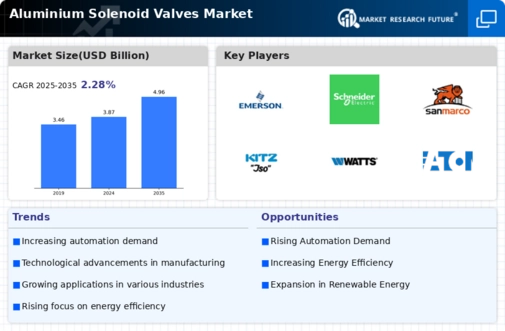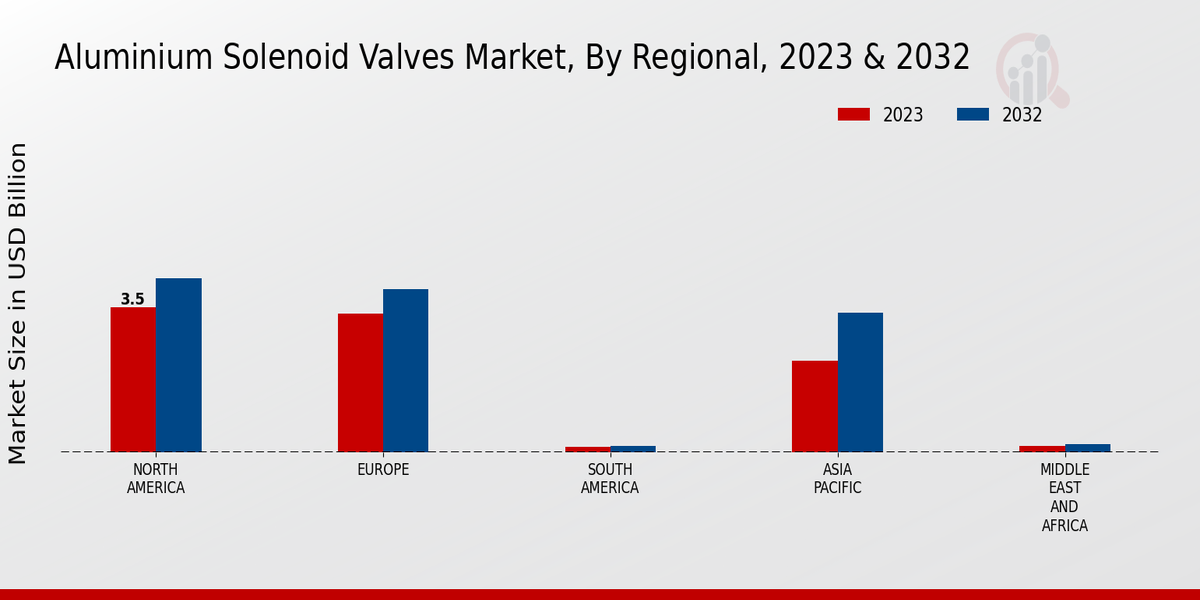Market Growth Projections
The Global Aluminium Solenoid Valves Market Industry is poised for significant growth, with projections indicating a market value of 3.87 USD Billion in 2024 and an anticipated increase to 4.96 USD Billion by 2035. This growth trajectory reflects a CAGR of 2.28% from 2025 to 2035, suggesting a steady demand for aluminium solenoid valves across various sectors. The market's expansion is likely driven by factors such as technological advancements, rising industrialization, and the increasing emphasis on sustainability. These projections highlight the potential for continued investment and innovation within the aluminium solenoid valve sector.
Technological Advancements
Technological innovations in solenoid valve design and functionality are propelling the Global Aluminium Solenoid Valves Market Industry forward. Advancements such as smart solenoid valves equipped with IoT capabilities are enhancing operational efficiency and enabling real-time monitoring. These innovations allow for better control and automation in various applications, including HVAC systems and industrial processes. As industries continue to embrace digital transformation, the demand for technologically advanced aluminium solenoid valves is likely to increase. This trend suggests a positive outlook for the market, with a projected CAGR of 2.28% from 2025 to 2035, indicating sustained growth driven by technological progress.
Growing Demand in Automation
The increasing adoption of automation across various industries is driving the Global Aluminium Solenoid Valves Market Industry. Industries such as manufacturing, automotive, and food processing are increasingly integrating automated systems to enhance efficiency and reduce operational costs. This trend is expected to contribute significantly to the market, with projections indicating a market value of 3.87 USD Billion in 2024. As companies seek to optimize their processes, the demand for reliable and efficient solenoid valves is likely to rise, further solidifying the position of aluminium solenoid valves in automated systems.
Sustainability and Lightweight Solutions
The shift towards sustainable and lightweight materials is influencing the Global Aluminium Solenoid Valves Market Industry. Aluminium, known for its lightweight properties and recyclability, is becoming a preferred choice for solenoid valves. This trend aligns with global efforts to reduce carbon footprints and enhance energy efficiency. Industries are increasingly recognizing the benefits of aluminium solenoid valves, which not only contribute to sustainability goals but also improve performance in various applications. As a result, the market is anticipated to grow steadily, with a projected value of 4.96 USD Billion by 2035, reflecting the increasing preference for eco-friendly solutions.
Regulatory Compliance and Safety Standards
The stringent regulatory compliance and safety standards in various industries are influencing the Global Aluminium Solenoid Valves Market Industry. Industries such as oil and gas, pharmaceuticals, and food processing are required to adhere to specific safety and quality regulations, which necessitate the use of reliable solenoid valves. Aluminium solenoid valves, known for their durability and performance, are increasingly being adopted to meet these standards. As regulatory frameworks evolve, the demand for compliant and high-quality solenoid valves is likely to rise, further driving market growth.
Rising Industrialization in Emerging Economies
The rapid industrialization in emerging economies is a significant driver for the Global Aluminium Solenoid Valves Market Industry. Countries in Asia-Pacific and Latin America are experiencing substantial growth in manufacturing and infrastructure development, leading to increased demand for solenoid valves. As industries expand, the need for efficient fluid control systems becomes paramount, thereby boosting the market for aluminium solenoid valves. This trend is expected to contribute to the overall market growth, as these regions invest in modernizing their industrial capabilities and enhancing production efficiency.











